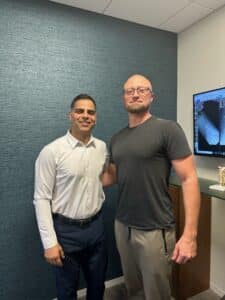
An Inspiring Story: Recovery After Spine Surgery
As Featured on Men’s Health Network: Thriving After Surgery

Men’s Health Network recently had the pleasure of interviewing the dynamic duo of Jama Anders, a professional weightlifter and longtime Crossfit instructor, and his spine surgeon, Dr. Ehsan Jazini, who, in a seemingly miraculous intervention, was able to perform a disc replacement on Jama that would allow him to recover full mobility. The story provides an ideal model for patient-doctor partnerships, and Jama’s hard-won return to Crossfit can inspire all the men struggling to navigate their health in an increasingly complex system.
Jama became a Crossfit instructor in his mid-20s. He describes being drawn to the program because of its empowering capacity, saying: “It is empowering to be stronger. You feel better, but it’s not just physical, it’s mental as well. Especially with CrossFit, it’s a little higher intensity, it makes you feel like you can tackle anything in life.”
He continues, “It makes you feel like, if I can do this in the gym, life is almost easier.”
Jama also cites the unique element of community as contributing to his love for Crossfit: “Crossfit is for the service members, the soccer moms…everyone welcomes them in the door. They want to help them get better. It’s a really cool environment.”
But, while high-intensity, competitive programs such as Crossfit can be both physically and socially rewarding, prevention, as always, is a necessary investment. Even individuals as dedicated to fitness and health as Jama can experience weightlifting-related injuries: “It didn’t take much at all for something to happen, that little tweak, the herniated disc at the nerve and you’re like: here it is. And it just got to where it was worse and worse.” What Jama was experiencing was a shockingly common affliction in the spine called sciatica, what Dr. Jazini calls a “very sharp, severe, almost stabbing type pain. It goes all the way down the legs.”

Jama’s sciatica pain was so extreme, he describes having to lie down in his truck bed: “I would have to lay in the back of the car or lay in my truck bed while my wife drove the truck because I could not take driving. I could not take sitting. So I just lay down until we got there.” He even recalls being afraid to sneeze, petrified that a single awkward movement could cause irrevocable damage. Discussing how the pain slowly escalated over decades, Jama illustrates the dread inherent to chronic pain like sciatica: “It’s just one of those things where the pain went away, healed up, and then it progressively got to where once a year I would have an episode, then twice per year, then quarterly…then in my 40s it got to a point where I would have to be careful walking the dog.”
But Jama was determined to persevere.
He sought out treatments all across the country, perpetually and vigilantly researching various alternative therapies and approaches. But the consensus amongst the doctors Jama spoke to was this: if you want to treat the sciatica pain, you will likely have to sacrifice your mobility, and sacrifice it permanently. Jama was resolute:
“I didn’t want that. I wanted to get back to myself again.”
Then Jama met Dr. Ehsan Jazini. Jama describes their first meeting: “Jazini was very patient, very kind…he didn’t look at me as an athlete or a weightlifter or crossfitter. He looked at my MRI, and he said to me: ‘I don’t know how you’re sitting there right now, with that degree of pain.’” In speaking with Dr. Jazini, it became obvious to me why Jama was so appreciative, and, frankly, relieved to discover Dr. Jazini and his practice. At the beginning of our interview, Dr. Jazini clearly articulated that those who participate in programs like Crossfit should not be blamed, admonished, or lectured for their fitness choices; all physical activity naturally entails a certain amount of risk. Jazini says, “If you drive your car a certain amount, eventually you need to replace it. Same thing happens to our bodies.”
This sympathetic approach is critical, particularly for men, who are often chastised as impulsive, reckless, or somehow careless regarding their health. Regardless of gender, patients across the board seldom report feeling validated, supported, and empowered after leaving the doctor’s office. Jama, for instance, described his pain being underestimated and minimized on multiple occasions: “I work pretty hard to stay in shape, so when I go to a doctor, I don’t look like that person who is in excruciating pain.” Throughout his long-winded search for optimal treatment, Jama recalled a sense of helplessness, saying “Mentally it got to be a huge struggle…it got pretty dark, just hurting all the time. You get pretty dark in those thoughts like, I’m never getting out of this pain.”

During our conversation, Jama also elucidated how men may try to conceal their pain. He said, “as a husband, as a father, as a coach…you’re always, as that strong male figure, trying to hide it, the pain you’re in. You feel like you’re letting down your family more and more. There’s things I couldn’t do.” So, like many men with families, jobs, and responsibilities–Jama learned to repress or otherwise mask his pain; for precisely that reason, then, Jama simply could not convince doctors to take his word: to affirm that he was suffering. This type of minimization or trivialization of health concerns can shut people off from seeking help completely. And, to be fair, they really can’t be blamed for it when this is such a ubiquitous experience.
That is why Dr. Jazini’s approach–emphasizing patient-doctor partnerships, multidisciplinary teams, and holistic health–is such a breath of fresh air. I asked Jazini what his best advice would be for other healthcare professionals.
Here is what he had to say:
“Build confidence in the patient by understanding that he is suffering and giving him options, a full toolbox. Educate them, talk to them intelligently about the risk and benefits of all options, and come together to decide on a plan that works for the individual.” Jazini’s approach to providing care is one in which “you treat the person, not the picture.”
Learn More about his Treatment
In other words, he recognizes the necessity of an individualized, specialized plan for care, treatment, and recovery alike. This vision of healthcare, while certainly ideal and commendable, has not seen widespread adaptation, because, as Jazini explains, it has only recently become a possibility. The doctor characterized traditional models of healthcare as being significantly more standardized: “My mentors, from 20 years ago, the approach was very paternalistic. This is what you have to do, this is the prescription, this is the surgery, that’s it.” Favoring a generalized approach, Jazini’s predecessors in the medical field have a proclivity to overlook the idiosyncrasies, externalities, and complex constellations of variables that factor into an individual’s health.
Dr. Jazini also described older methods as prioritizing clinical detachment and hierarchy, based on a “very one-sided channel of communication.” According to Jazini, though, things are looking up with regard to patient-centric approaches: “The medical field, society as a whole, has become much more in tune and adept at understanding that in order to get good results, you need to see the person as a whole.”
This model of medical treatment does not shy away from cultivating rapport, trust, and empathy between patients and their respective providers. Jazini illustrates how sharing personal stories and extending sympathy has resulted in some great success stories, including that of Jama: “To tell my own story, my own struggles…to relate to the patient. If the person feels like they can relate to you on an emotional level, then you can begin to have a deep conversation, that’s actually very productive. It just takes time. You have to show empathy, you can’t fake it.”
This sense of relatability and understanding, I would argue, could substantially transform and solidify the patient-provider relationship–especially about male patients. Men often operate under the assumption that no one is there solely to help them. Because of this tendency, men will often “downplay their symptoms.” This can lend itself to a particular feedback loop, in which male patients will conceal their pain, thus further alienating themselves, and ultimately, become convinced that their problem is completely singular, chronic, and incurable. Jama articulated this cyclical helplessness perfectly, saying
“As a man you feel like the only one, nobody has back pain like I have back pain…you come to realize there are plenty of people in that position.”
And that sense of solidarity doubles as inspiration, as hope. Once somebody in horrible pain realizes that others have not only endured what they are enduring but has come out the other side of it, stronger than ever–that person now has a model to follow, something to cling to when the pain feels insurmountable.
And while not all men are as motivated as Jama, his story can still serve as a testament to the fact that medical treatment can work, sometimes it can work to a remarkable degree. The problem is that people lack the options, knowledge, and resources–oftentimes lack access altogether. There is an innumerable constituency of men out there who have withdrawn almost completely from their health, from engaging in it actively. Not only are they not being educated about the potential options for treatment, they are not even being fully listened to, understood, and evaluated. Men, and the patient population at large, need to start demanding more from healthcare providers. In the meantime, Dr. Jazini’s message to those experiencing chronic pain stands: “My main message is: you’re not alone. Don’t settle, seek help. Don’t just take the first opinion, get as many as possible so you can find the best option for you.”
In light of his inspiring recovery, Jama has this wisdom to offer:
“In the recovery process, you are always doubting. You have fear that just that one wrong move will cancel out all the work it took to get back here. You’re just thinking, I don’t want to mess this up.”
He continues,
“But, you have to find a way around that fear.”
Topics covered
About the Author
Featured Resources
Insights to Achieve a Pain-Free Life



